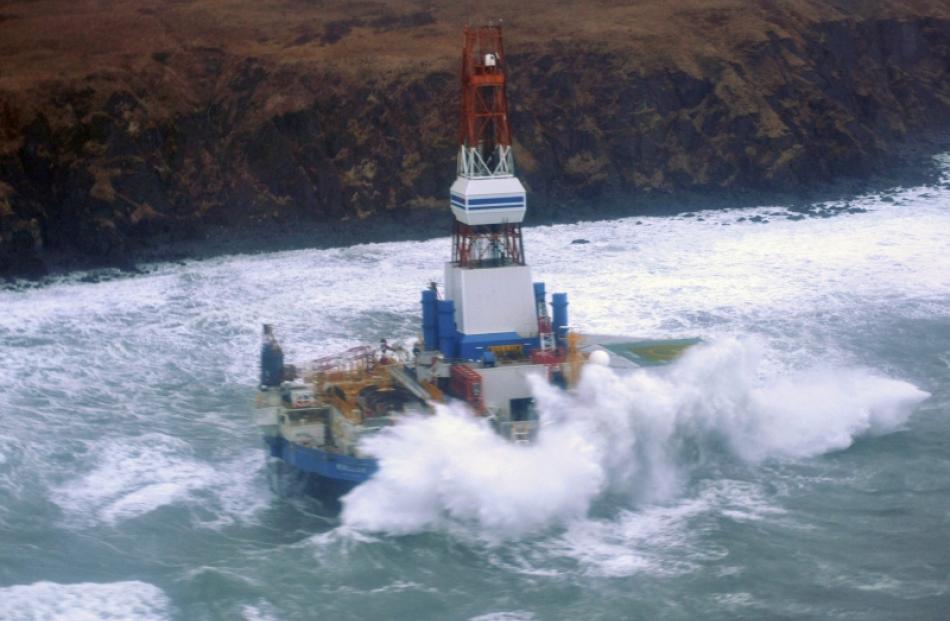The runaway oil rig that ran aground in Alaska on New Year's Eve dragged two vessels trying to control it more than 16km toward shore in just over an hour before the crews cut it loose to save themselves in "near hurricane" conditions.
Details were still emerging on Wednesday from the U.S. Coast Guard and Royal Dutch/Shell, the company at the center of a controversial and accident-prone Arctic oil drilling programme of which the Kulluk drillship is a vital part.
They paint a frightening picture of the 28,000-tonne, saucer-shaped rig being thrust toward the shore on waves up to 11m high driven by winds up to 100km, pulling its main towing vessel, the Aiviq, and a tug, the Alert, behind it.
"We are talking about near hurricane-strength conditions," said Darci Sinclair of the Kulluk Tow Incident Unified Command, set up by the U.S. Coast Guard and the companies involved. "Regaining control became extremely challenging."
The unified command said the Kulluk was now "upright and stable" on Sitkalidak Island in the Gulf of Alaska. Six salvage experts spent three hours aboard it on Wednesday (local time) for a structural assessment to be used by Netherlands-based Smit Salvage.
Smit had worked on the Selendang Ayu, a ship that broke in half and spilled fuel and soybeans after grounding in bad December weather off Unalaska Island in 2004. Smit also worked on the Costa Concordia, which grounded off Italy last year.
More than 600 people were involved in the Kulluk response effort.
"This is a very large and complex response and it is important that the American public and our elected officials understand the dangerous and difficult challenges being faced by the response crews," Rear Admiral Thomas Ostebo, commander of the Coast Guard in Alaska, said in the statement.
The 30-year-old Kulluk is operated by Noble Corp and was refitted by Shell for its summer 2012 drilling expedition in the Beaufort Sea off northern Alaska.
Shell spent $US4.5 billion preparing for extraction activities there and in the Chukchi Sea further east, but has yet to complete a single well, while facing some embarrassing setbacks.
Headlines that raise questions about the wisdom of drilling so far north in such a environmentally delicate and technically challenging place were not expected so early in 2013, given that activity stopped for the season two months ago.
Any Kulluk damage could threaten Shell's 2013 drilling programme because its oil-spill plans require a second rig to be available at all times in case a relief well needs to be drilled to kill the well. That is the Noble-owned Discoverer, which would also be unable to drill without another rig nearby.
David Smith, spokesman at the Bureau of Safety and Environmental Enforcement in Washington DC, said his division would not yet speculate on the summer. The earliest date that the drilling season could have started last year was July 1.
The Kulluk was on its way south for the winter. It had been towed east from the Beaufort, and then south through the Bering Strait that separates the northernmost U.S. state from Siberia.
On December 28, about half-way to its winter destination in Seattle, and 80km south of Kodiak Island in the Gulf of Alaska, engine failure struck the Aiviq - an icebreaker that is less than a year old, and whose name means "Walrus".
The weather was already rough and the Kulluk's 18-strong crew had earlier been lifted off when a doomed four-day battle to keep the Kulluk off the rocks began.
The effort ran into deeper difficulty a few hours after nightfall on Dec. 31, with the shore less than 19 miles away.
Aiviq, one of two vessels attached at the time, lost its line. It was re-attached, and battled on against the elements along with the Alert, but the coastline kept getting closer as the storm pushed all three vessels north-eastwards.
At 8.15pm on Monday (local time), the order came to cut the Kulluk lines to save the Aiviq, the Alert and the crews.
At 8.30pm, the lines were cut, and by 8:48pm, a trajectory map on the unified command website shows, the Kulluk was aground about 1,600 feet from the shore on Sitkalidak Island, near the larger Kodiak Island. The Kulluk, the wind, and the waves had dragged Aiviq and Alert more than 16km in just over an hour.
The vessel settled on what one Coast Guard official described as "loose rock and sand".
Noble had no immediate comment. Shell in London has made a series of statements on the progress of the operation, but had nothing to add on Wednesday, and referred calls to the unified command. Shell in Houston could not be reached for comment.
'One disaster to the next'
The spill risk from the drillship is limited to the 143,000 gallons of ultra-low-sulfur diesel and 12,000 gallons of other oil products on board. Still, opponents of Arctic drilling said the accident showed Shell was unable to keep the Arctic safe.
"Shell has lurched from one Arctic disaster to the next, displaying staggering ineptitude every step of the way," Greenpeace campaigner Ben Ayliffe said on Wednesday.
"Were the pristine environment of the frozen north not at risk of an oil spill it would be almost comical. Instead it's tragic," Ayliffe said. "We're moving closer to a major catastrophe in the Arctic and the U.S. government appears unwilling to provide either the needed oversight or emergency backup the company's incompetence requires."
Shell's Arctic campaign has been bedeviled by problems. The Coast Guard briefly detained the Discoverer in December in Seward, Alaska, on safety concerns. A mandatory oil-containment barge, the Arctic Challenger, failed for months to meet requirements for seaworthiness, and a ship mishap resulted in damage to a key piece of equipment intended to cap a blown well.
Asked why the Kulluk was still at sea two months after work stopped, one contract drilling source said the "demobilisation" process after drilling can take days or weeks depending on the rig model and its anchoring. It was also possible the weather was rough enough over the last few months to delay transit.
Replacing the Kulluk, if it ends up being badly damaged, would add to the cost of the accident for Shell, which must reimburse the federal and state governments for response costs.
The Discoverer, which it has under a contract with Noble, costs Shell $US240,000 per day - or a few-hundred million dollars over the life of the two-year contract. Shell had to spend $US292 million upgrading the Kulluk, when was built in 1983 and had been slated to be scrapped before Shell bought it in 2005.













